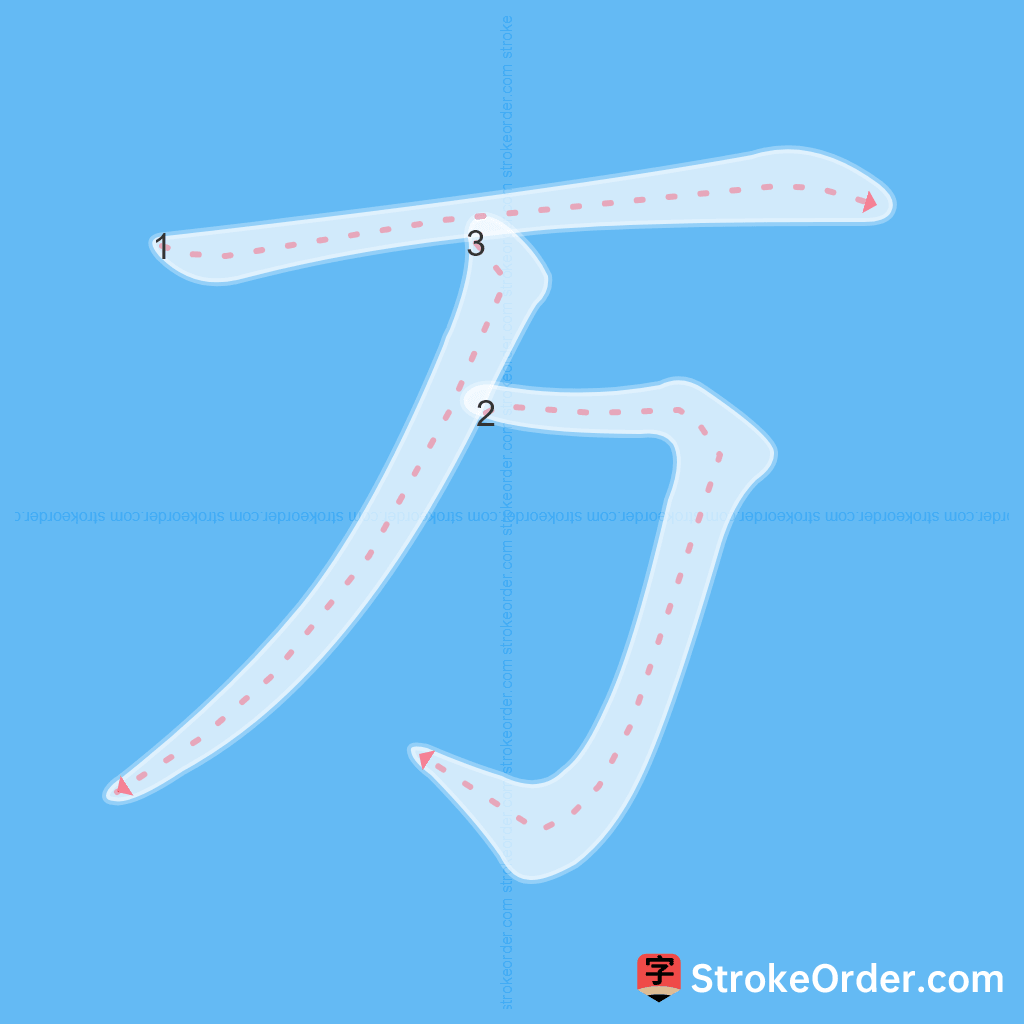万 Stroke Order
Animated Stroke Order of 万

Stroke Order Diagrams for 万

Step-by-Step Handwriting Guide for 万

Learn to Write Chinese Characters with Video Tutorials
Watch the video of writing the Chinese character "万", learn the correct stroke order (笔顺) of the character "万", and master the standard way of writing the character "万".
Free Printable Handwriting Practice with Stroke Order: 万
Printable Writing Practice Worksheet of "万" in Portrait Orientation (Tian Zi Ge)

Printable Writing Practice Worksheet of "万" in Landscape Orientation (Tian Zi Ge)

Information of 万
Pinyin
wàn、 mò
Radical
一
Strokes
3 strokes
Usage
★★★★★
Definition
Wan (surname) / ten thousand / a great number
万 wàn
1. **Number**: Refers to ten times a thousand; ten thousand.
Ten thousand households (万户侯, the highest rank of marquise during the Han Dynasty in China, enjoying taxes from ten thousand households; generally referred to as high officials).
2. **Metaphor for a Large Quantity**: Extremely numerous.
Ten thousand things (万物). Ten thousand directions (万方, meaning both nationwide and various appearances). Daily occurrences reach a myriad (日理万机). Weather is extremely varied (气象万千).
3. **Extremely**: Very, absolutely.
Extremely [often used for emphasis] (万分). Extremely fortunate (万幸).
4. **Surname**: A family name.
万 wàn
1. **Scorpion**: [Traditional Meaning] Refers to a type of insect (scorpion).
2. **Numerical Term**: Ten times a thousand.
Example: "Today’s salary exceeds one hundred thousand..." (唐·元稹《遣悲怀》).
Further examples include:
- Ten thousand years (万寿, used to refer to the birthday of emperors and empresses).
- Ten thousand calamities (万劫, denoting an exceedingly long time).
- Ten thousand households (万户).
- Ten thousand acres (万顷, referring to one million acres).
3. **Name of an Ancient Dance**: Refers to a specific dance form in antiquity.
4. **Historical Administrative Division**: The name of an ancient prefecture ([En.] Wan prefecture).
5. **Established in the Second Year of the Great Unity (大同)**: Located in Shicheng (now Daxian County, Sichuan Province).
6. **Changed from Puzhou in the Eighth Year of the Zhenguan Era**: Located in Nanpu (now Wanzhou, Chongqing).
7. **Established in the First Year of the Hongwu Era**: Governed from Wan'an (now Wanning County, Guangdong Province).
8. **County Name**: Refers to Wan County, located on the north bank of the Yangtze River in eastern Sichuan Province.
9. **Times/Multiples**: Used in contexts indicating a multiple or degree (倍).
10. **Surname**: Common family name.
万 wàn
1. **Adjective**: Used to express a multitude or vast quantity.
Examples include:
- "Ten thousand feet tall" (高万仞).
- "Ten thousand miles to the war" (万里赴戎机).
2. **Variedade**: Used to emphasize that things are not the same at all; various.
Example: “Ten thousand transformations” (万化, meaning various changes).
万 wàn
1. **Adverb**: Indicates absolute certainty.
Example: “Absolutely no doubt” (万无).
2. **See also**: Reference to definitions under another pinyin ‘mò’.
[Additional Note]
- 万俟 (wāng qí): Originally a name of a tribe from ancient China, later became a compound surname.
thousands of horses, all mute (idiom); no-one dares to speak out / an atmosphere of political oppression
lit. by the thousands and tens of thousands (idiom); untold numbers / innumerable / thousands upon thousands
be filled with a thousand regrets / All sorts of feelings well up in one's mind. / be filled with regrets
Input Method for 万
Pinyin
wan4
Wubi
dnv|gqe
Cangjie
ms
Zhengma
-
Four Corner
10227
Unicode
U+4e07
Same Pronunciation Characters